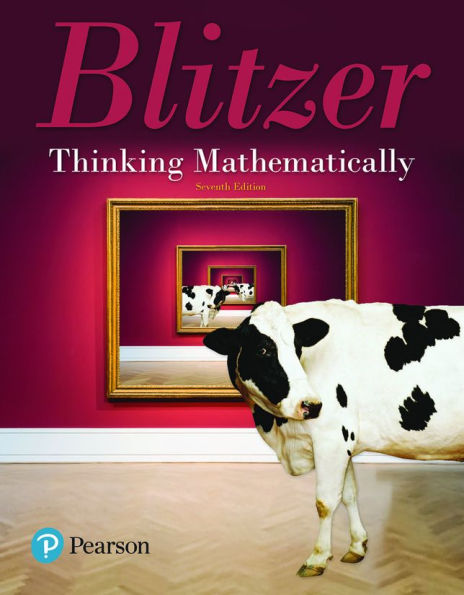For courses in Liberal Arts Mathematics.
Show students their world is profoundly mathematical, meaningful, and fun
Students often struggle to find the relevance of math in their everyday lives. In Thinking Mathematically, 7th Edition, Bob Blitzer’s distinctive and relatable voice engages students in the world of math through compelling, real-world applications — student-loan debt, time breakdown for an average NFL broadcast, and many more.
Understanding that most students in this course are not math majors (and are unlikely to take another math class), Blitzer uses current data compiled from hundreds of books, magazines, and online sources to show students how truly meaningful and fun math can be.
Also available with MyLab Math
MyLab™ is the teaching and learning platform that empowers you to reach every student. By combining trusted author content with digital tools and a flexible platform, MyLab personalizes the learning experience and improves results for each student.
Note: You are purchasing a standalone product; MyLab Math does not come packaged with this content. Students, if interested in purchasing this title with MyLab Math, ask your instructor to confirm the correct package ISBN and Course ID. Instructors, contact your Pearson representative for more information.
If you would like to purchase both the physical text and MyLab Math, search for:
0135167450 / 9780135167458 Thinking Mathematically, Books a la Carte Plus MyLab Math - Access Card Package
Package consists of:
- 0134686519 / 9780134686516 Thinking Mathematically, Books a la Carte Edition
- 0134705092 / 9780134705095 MyLab Math with Pearson eText - Access Card - for Thinking Mathematically, 7/e
For courses in Liberal Arts Mathematics.
Show students their world is profoundly mathematical, meaningful, and fun
Students often struggle to find the relevance of math in their everyday lives. In Thinking Mathematically, 7th Edition, Bob Blitzer’s distinctive and relatable voice engages students in the world of math through compelling, real-world applications — student-loan debt, time breakdown for an average NFL broadcast, and many more.
Understanding that most students in this course are not math majors (and are unlikely to take another math class), Blitzer uses current data compiled from hundreds of books, magazines, and online sources to show students how truly meaningful and fun math can be.
Also available with MyLab Math
MyLab™ is the teaching and learning platform that empowers you to reach every student. By combining trusted author content with digital tools and a flexible platform, MyLab personalizes the learning experience and improves results for each student.
Note: You are purchasing a standalone product; MyLab Math does not come packaged with this content. Students, if interested in purchasing this title with MyLab Math, ask your instructor to confirm the correct package ISBN and Course ID. Instructors, contact your Pearson representative for more information.
If you would like to purchase both the physical text and MyLab Math, search for:
0135167450 / 9780135167458 Thinking Mathematically, Books a la Carte Plus MyLab Math - Access Card Package
Package consists of:
- 0134686519 / 9780134686516 Thinking Mathematically, Books a la Carte Edition
- 0134705092 / 9780134705095 MyLab Math with Pearson eText - Access Card - for Thinking Mathematically, 7/e

Thinking Mathematically
1064
Thinking Mathematically
1064(7th ed.)

Product Details
| ISBN-13: | 9780134686516 |
|---|---|
| Publisher: | Pearson Education |
| Publication date: | 01/02/2018 |
| Edition description: | 7th ed. |
| Pages: | 1064 |
| Product dimensions: | 8.30(w) x 10.80(h) x 1.20(d) |
